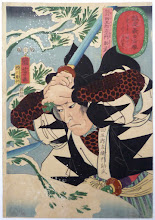For the magic item subtables in the Basic Set, first you should roll a percentage die to determine the type of item, and then a d20 on the particular item type table. Since the magic item type table has everything in increments of 5%, I'm not sure why it's not also a d20 table. Maybe to keep it compatible with the d% tables for each type in the Expert Set later?
Anyway, one in four items will be a potion (25%), one in every five magic items is going to be a magic sword or a magic scroll (20% each), one in ten will be another sort of weapon or magical armor (10% each, although, as we shall see, armor is sometimes two magic items), and one in twenty will be a magic ring, wand/staff/rod, or miscellaneous item (5% each).
Swords are pretty much the most popular weapon from the get-go anyway, but if you want to be all cool and stylish and use another weapon as your go-to weapon at character creation, by the book at least, you're probably going to switch to using a sword later on, just because magical swords are so much more common than other types of magical weapons. Magical swords are twice as common as all other types of weapons put together. [Of course, what DM hasn't had a player with a stylish but (usually) suboptimal choice of preferred weapon, and not thrown them a bone and had them find a magical version by DM fiat rather than waiting for it to come up by random roll, if ever?]
Anyway, moving on to the specific subtables, the first of course is swords. There are eight types of swords, and there is a 40% chance to get a plain old sword +1 (although at these levels, it's not yet a 'plain old' magical weapon), a 55% chance to get a sword +1 with an ability of some kind, and a 5% chance to get a sword +2. The possible special abilities are a sword +1/+2 vs. lycanthropes, a sword +1/+2 vs. spell-users, a sword +1/+3 vs. undead, a sword +1/+3 vs .dragons, a sword +1 light spell 1/day, or a sword +1 cure light wounds spell 1/day.
Other weapons could be 10 arrows +1 (20%), an axe +1 (10%, either type I suppose), a dagger +1 (15%) or +2 (5%), a mace +1 (15%), 10 quarrels +1 (15%), a sling +1 (5%), or a war hammer +1 (15%). If you're a Basic level character who uses a spear, club, or pole arm, you're out of luck until level 4. It's also interesting that there are no magical bows or crossbows, only their ammunition, but there's a magical sling rather than ammunition.
For magical armor, there are six types of armor to be rolled: leather +1 (20%), chainmail +1 (25%), plate mail +1 (10%), shield +1 (30%) or +2 (10%), and the above mentioned set of chainmail and shield, both +1 (5%). So you've got a half a percent chance to get two items instead of only one when rolling for magical treasure. And really, most parties are going to split that magical armor and shield up if it gets discovered, unless the party unearths a fair amount of magical treasure in one go.
There are eight types of potions: diminution (20%), ESP (10%), gaseous form (15%), growth (15%), healing (20%), invisibility (5%), levitation (10%), and poison (5%). So, healing is the most common, and poison (thankfully) the least common type. And a nice spread of abilities. Growth and strength have the ability to double melee damage, and growth obviously has some other benefits and drawbacks. Gaseous form, diminution, growth, levitation, strength and invisibility are useful "getting around obstacles" abilities.
For scrolls, there can be scrolls with 1 spell (20%), 2 spells (15%) or 3 spells (5%), a curse (10%), protection from lycanthropes (15%), protection from undead (15%), a treasure map to 1~4k gold (10%), or a treasure map to a magic item (10%). I'm not personally fond of having treasure maps as "magic items." I'd much rather just leave maps laying around when I think it's appropriate, and give out actual magic items when I roll them. But that's just me.
There are six types of magic rings: animal control (15%), fire resistance (25%), invisibility (10%), protection +1 (25%), water walking (15%), and weakness (10%). Half of all rings at this level of play will be protective, three have utility powers, and one is cursed. Not too shabby a spread of powers.
There are three wands, two staves and one rod on the lists: wand of enemy detection (30%), wand of magic detection (25%), wand of paralyzation (15%), staff of healing (15%), snake staff (5%), and rod of cancellation (10%). Back in the day, I used to think the "detect X" wands (and later in the Expert and Companion Sets magic swords) were kinda lame. Now, being older and wiser, I like them a lot. They allow a clever group of players to scout out information about dungeons that can help them to level uneven playing fields (or tips scales in their favor) before entering combat, or to get the gold without a fight.
There are ten different miscellaneous magic items: bag of devouring (10%), bag of holding (15%), crystal ball (5%), elven cloak (10%), elven boots (10%), gauntlets of ogre power (5%), helm of alignment changing (10%), helm of telepathy (15%), medallion of ESP (10%), or a rope of climbing (10%). There are actually some powerful items here, for low level play. And since they become much more rare in an Expert level game, it's nice to be able to find them at low levels. Of course, unlike some of the other treasure types, there are two cursed items on the list, while each other type of item called.
More on magic item descriptions tomorrow (at least I hope tomorrow, by the end of the month at least!).
The "Competition"
3 hours ago






